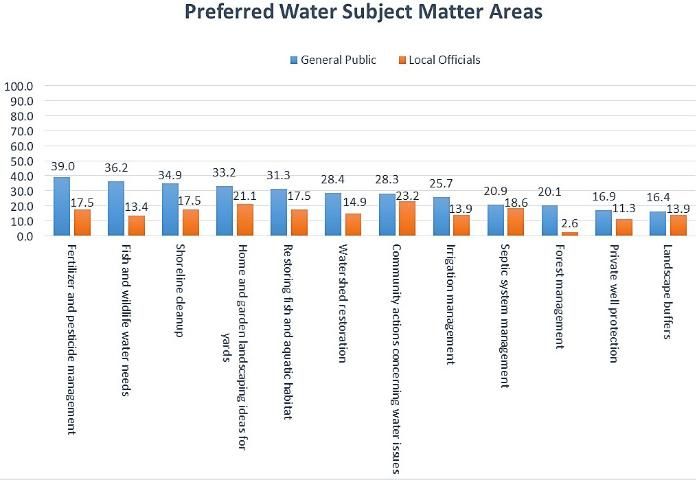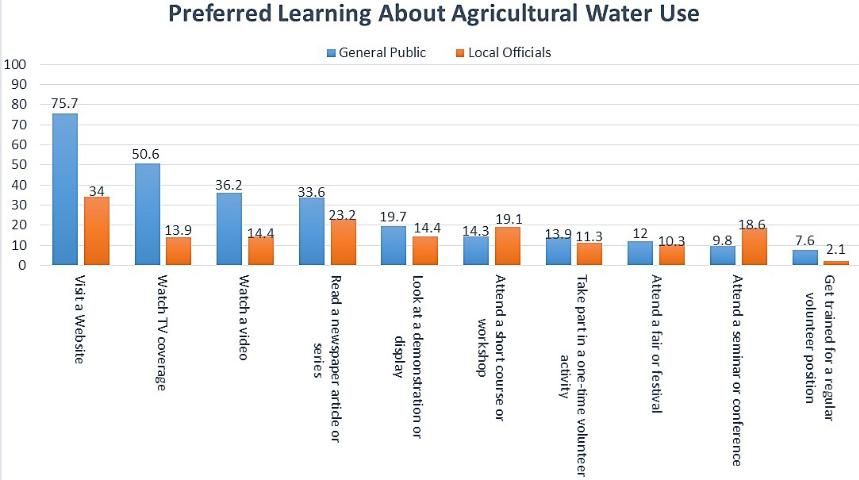This EDIS document is the third in a series describing preferred ways of learning about agricultural water use in Florida. This study can be used to assist Extension educators and the agricultural industry at large in the development of strategies meant to inform people about the realities of agricultural water use in Florida. The series includes the following EDIS documents:
- Attitudes and Perceptions of Agricultural Water Use in Florida Expressed by the General Public and Local Officials, https://edis.ifas.ufl.edu/publication/wc248
- Differences in Perceptions of Agricultural Water Use Between the General Public and Local Officials, https://edis.ifas.ufl.edu/publication/wc249
- How the General Public and Local Officials Prefer to Learn about Agricultural Water Use in Florida, https://edis.ifas.ufl.edu/publication/wc247
Introduction
Water is a precious resource that is invaluable to the state of Florida (Marella, 2015). However, over the past decade, Florida has consistently ranked among one of the top four states with the highest amount of water withdrawn in the nation (Hutson et al., 2009; Maupin et al., 2014; USGS, 2015). According to the Florida Department of Environmental Protection, the amount of water being used daily in the state is estimated at 14, 237 million gallons per day. Approximately 49% of groundwater withdrawals are accounted for by the general public supply, followed by 34% being used for agricultural purposes, 7% for commercial industry, and 9% for recreational-landscape irrigation (Marella, 2015).
In determining the future demands on water, more information is needed for the general public and local officials to make informed decisions about whether the agricultural sector uses water appropriately. Understanding preferred learning mediums can help Extension educators provide useful information about agricultural water use. Therefore, identifying the preferred way the general public and local officials want to learn about agricultural water use in Florida is necessary.
Uses and Gratifications of General Public and Local Officials
Previous research studies have shown that individuals have a preferred way of gaining information (Ota, DiCarlo, Burts, Laird, & Gioe, 2006). The public is likely to gather information and develop preconceived ideas from media sources such as newspapers, articles, blogs, and television broadcasts (Oxarart & Monroe, 2012). According to Stone, Singletary, and Richmond (1999), Uses and Gratifications Theory (U&G) assumes that "audiences seek out media in a goal-directed way that affords them with the means to gratify a wide range of needs" (1999, p. 201). U&G focuses on media behaviors from the audience's viewpoint, an approach that acknowledges that people are in control of their media choice (Lin, 1996). In general, individuals seek out the best media channel that is most conducive to fulfilling their needs (Lin, 1996).
Identifying Preferred Learning Methods for Agricultural Water Use
Preferred learning methods related to gaining knowledge about agricultural water use were identified through an online survey, which was implemented with both the general public and local officials in the state of Florida. Local officials, also known as decision makers, consist of local county commissioners, county clerks, and county managers; all of these subgroups were targeted for this study. The survey instrument was adopted from the 2012 RBC Canadian Water Attitudes Study (Patterson, 2012) and modified to fit issues pertaining to Florida.
Respondents were first asked about the water topics they were most interested in learning about and their preferred methods for learning about those topics. Next, both groups were provided with a list of water-related topics, such as community actions concerning water issues, fertilizer and pesticide management, and fish and wildlife water needs. They were also asked to indicate any additional topics they were interested in learning more about. In addition, respondents were provided a list of learning opportunities pertaining to agricultural water use and asked to select those that interest them.
Learning Preferences
Respondents were asked what water subjects they would be most interested in learning more about. Respondents were allowed to select more than one answer. Results can be seen in Figure 1. Overall, the general public showed more interest in learning about water issues than county-level local officials. The general public was most interested in (1) fertilizer and pesticide management (39.0%), (2) fish and wildlife water needs (36.2%), (3) shoreline cleanup (34.9%), and (4) home and garden landscaping ideas for Florida yards (33.2%). The local officials were most interested in (1) community actions concerning water issues (23.2%) and (2) home and garden landscaping ideas for Florida yards (21.1%).

Learning Modes
Results regarding how the public and county-level local officials would like to learn about agricultural water issues are displayed in Figure 2. Overall, the general public would like to learn through visiting a website (75.7%), watching TV coverage (50.6%), or watching a video (36.2%), while local officials would like to learn through visiting a website (34.0%), reading a newspaper article or series (23.2%), attending a short course or workshop (19.1%), or attending a seminar or conference (18.6%).

Results/Implications for Practice
This study focused on the preferred ways the general public and local officials want to learn about agricultural water use and various related topics. The findings are consistent with Stone et al. (1999), which showed that both the general public and local officials seek out media in a goal-directed way that benefits them. For example, local officials had a higher interest than the general public in attending learning opportunities that required face-to-face contact, such as attending a short course or attending a conference.
Given the results, Extension educators should invest more time in creating websites for the general public, particularly about topics related to fertilizer and pesticide management, fish and wildlife water needs, and shoreline cleanup. Extension educators should also think about planning activities that bring residents and local officials together to address community actions concerning water issues and to provide local officials insight into what their constituents care about. In addition, planning home and garden landscaping demonstrations related to Florida residents would be beneficial to the general public and local officials.
Lastly, Extension educators should invest more time in providing workshops, seminars, and forums focused on agricultural water use for decision-makers. Since the general public and local officials desired web-based learning opportunities, incorporating interactive videos and messaging can provide local officials the chance to achieve in-person contact, which they indicated they prefer, while offering an online environment for the general public. In addition, Extension educators should maximize various media channels to increase the overall knowledge of agricultural water usage to both audiences.
Summary
Understanding the general public's and local officials' preferred ways of learning about agricultural water use is an important and complex issue that needs to be addressed. Since agriculture plays an important role in the state, it is worth the effort to ensure that a variety of learning opportunities is made available for the public as well as local officials. This can ensure that these individuals make an informed decision considering future policies concerning agricultural water use.
References
Hutson, S. S., Barber, N. L., Kenny, J. F., Linsey, K. S., Lumia, D. S., & Maupin, M. A., (2009). Estimated use of water in the United States in 2005: U.S. Geological Survey Circular. Retrieved from https://pubs.usgs.gov/circ/1344/pdf/c1344.pdf
Lin, C. A. (1996). Looking back: The contribution of Blumler and Katz's uses of mass communication' to communication research. Journal of Broadcasting & Electronic Media, 40(4), 574–581.
Marella, R. L. (2015). Water withdrawals in Florida, 2012 (No. 2015-1156). US Geological Survey. Retrieved from https://pubs.er.usgs.gov/publication/ofr20151156
Maupin, M. A., Kenny, J. F., Hutson, S. S., Lovelace, J. K., Barber, N. L., & Linsey, K. S., (2014). Estimated use of water in the United States in 2010: U.S. Geological Survey Circular. Retrieved from https://doi.org/10.3133/cir1405
Ota, C., DiCarlo, C. F., Burts, D. C., Laird, R., & Gioe, C. (2006). Training and the needs of adult learners. Journal of Extension, 44(6). Retrieved from https://archives.joe.org/joe/2006december/tt5.php
Oxarart, A., & Monroe, M. C. (2012). Using interesting text to communicate complex natural resources issues. Journal of Extension, 50(1). Retrieved from https://archives.joe.org/joe/2012february/a8.php
Patterson, L. (2012). 2012 RBC Canadian water attitudes study. RBC Blue Water Project. Retrieved from http://www.rbc.com/community-sustainability/_assets-custom/pdf/CWAS-2012-report.pdf
Stone, G., Singletary, M., & Richmond, V. P. (1999). Clarifying communication theories: A hands-on approach (1st ed.). Iowa State University Press.
USGS Water Science School (2015).Water questions and answers: Which states use the most water? US Geological Survey. Retrieved from https://www.usgs.gov/special-topics/water-science-school/science/water-qa-which-states-use-most-water